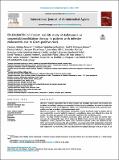Por favor, use este identificador para citar o enlazar a este item:
http://hdl.handle.net/10261/350297COMPARTIR / EXPORTAR:
 SHARE SHARE
 CORE
BASE CORE
BASE
|
|
| Visualizar otros formatos: MARC | Dublin Core | RDF | ORE | MODS | METS | DIDL | DATACITE | |

| Título: | EN-DALBACEN 2.0 Cohort: real-life study of dalbavancin as sequential/consolidation therapy in patients with infective endocarditis due to Gram-positive cocci |
Autor: | Hidalgo-Tenorio, Carmen; Sadyrbaeva-Dolgova, Svetlana; Enríquez-Gómez, Andrés; Muñoz, Patricia; Plata-Ciezar, Antonio; Miró, José María; Alarcón González, Arístides de CSIC ORCID; Martínez-Marcos, Francisco Javier; Loeches, Belén; Escrihuela-Vidal, Francesc; Vinuesa, David; Herrero, Carmen CSIC ORCID; Boix-Palop, Lucía; Arenas, María del Mar; García-Vázquez, Elisa; Arnaiz-De Las Revillas, Francisco; Pasquau, J.; on behalf of the EN-DALBACEN study group | Palabras clave: | Endocarditis Dalbavancin Cost-effective |
Fecha de publicación: | sep-2023 | Editor: | Elsevier | Citación: | International Journal of Antimicrobial Agents 62(3): 106918 (2023) | Resumen: | [Objectives] Infective endocarditis (IE) has high mortality and morbidity and requires long hospital stays to deliver the antibiotic treatment recommended in clinical practice guidelines. We aimed to analyse the health outcomes of the use of dalbavancin (DBV) in the consolidation treatment of IEs caused by Gram-positive cocci and to perform a pharmacoeconomic study. [Materials and methods] This observational, retrospective, Spanish multicentre study in patients with IE who received DBV as part of antibiotic treatment in consolidation phase were followed for at least 12 months. The study was approved by the Provincial Committee of the coordinating centre. [Results] The study included 124 subjects, 70.2% male, with a mean age of 67.4 years and median Charlson index of 4 (interquartile range: 2.5–6). Criteria for definite IE were met by 91.1%. Coagulase-negative staphylococci (38.8%), Staphylococcus aureus (22.6%), Enterococcus faecalis (19.4%), and Streptococcus Spp. (9.7%) were isolated more frequently, all susceptible to vancomycin. Before DVB administration, 91.2% had undergone surgery; 60.5% had received a second regimen for 24.5 d (16.6–56); and 20.2% had received a third regimen for 14.5 d (12–19.5). DBV was administered to facilitate discharge in 95.2% of cases. At 12 months, the effectiveness was of 95.9%, and there was 0.8% loss to follow-up, 0.8% IE-related death, and 3.2% relapse. Adverse events were recorded in 3.2%. The hospital stay was reduced by 14 d, and there was a mean savings of 5548.57 €/patient vs. conventional treatments. [Conclusion] DBV is highly effective, safe, and cost-effective as consolidation therapy in patients with IE by Gram-positive cocci, with few adverse events. |
Descripción: | © 2023 The Author(s). Published by Elsevier Ltd. This is an open access article under the CC BY-NC-ND license (http://creativecommons.org/licenses/by-nc-nd/4.0/) | Versión del editor: | https://doi.org/10.1016/j.ijantimicag.2023.106918 | URI: | http://hdl.handle.net/10261/350297 | DOI: | 10.1016/j.ijantimicag.2023.106918 | ISSN: | 0924-8579 | E-ISSN: | 1872-7913 |
| Aparece en las colecciones: | (IBIS) Artículos |
Ficheros en este ítem:
| Fichero | Descripción | Tamaño | Formato | |
|---|---|---|---|---|
| EN-DALBACEN_IJAA_2023_OA.pdf | 403,31 kB | Adobe PDF |  Visualizar/Abrir |
CORE Recommender
SCOPUSTM
Citations
7
checked on 21-abr-2024
Page view(s)
22
checked on 26-abr-2024
Download(s)
15
checked on 26-abr-2024
Google ScholarTM
Check
Altmetric
Altmetric
Este item está licenciado bajo una Licencia Creative Commons

